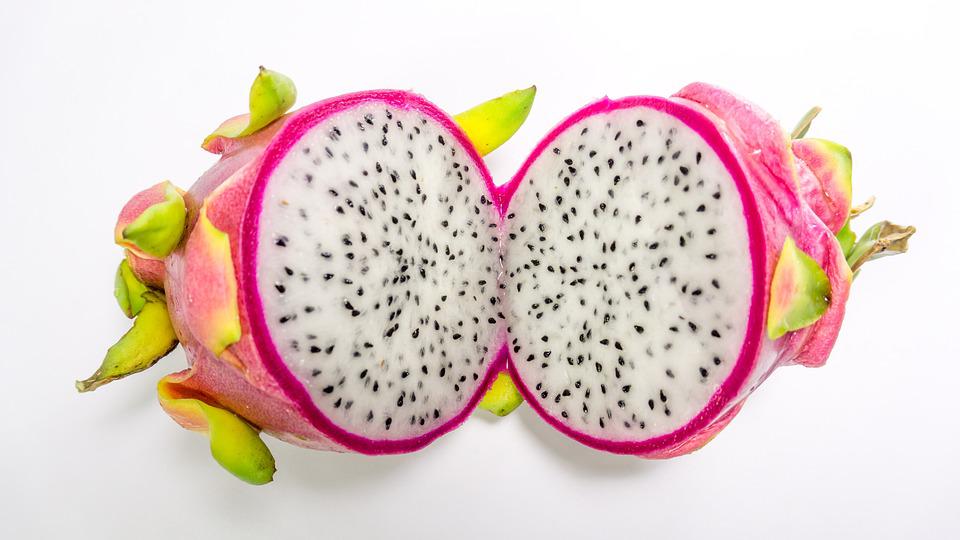Dragon fruit, or pitaya, is not only visually striking but also has a number of health benefits. It is packed with antioxidants and essential vitamins like vitamin C, which can help boost the immune system and protect against disease (2). Additionally, dragon fruit is a good source of fiber, which can aid in digestion and promote satiety, making it a great addition to a weight loss or weight management diet (3). The fruit is also rich in magnesium and calcium, which can help promote bone health, and contains compounds that may help regulate blood sugar levels (4, 5).
Dragon fruits is rich in fiber, minerals and vitamins that make it very beneficial for the health. It also contains many polyphenolic compounds that have antioxidant and anti-inflammatory properties that our bodies need (2). Here are a few of the health benefits of dragon fruit.
- Helps with digestion. Dragon fruit is loaded with fiber which increases movements in the gastrointestinal tract. They absorb water in the intestines and add bulk to stools thus preventing constipation. By lubricating the gut and easing the passage of food and waste, they also prevent hemorrhoids (swelling of veins in the lower rectum and anus) which can cause piles, bleeding, itching and pain (3).
- Dragon fruit has various health benefits, including reducing cholesterol levels. The soluble fiber present in dragon fruit can help reduce cholesterol by binding to them in the small intestines, preventing their absorption into the bloodstream. This can help prevent fat buildup in the walls of arteries, reducing the risk of atherosclerosis and coronary heart disease (4). Additionally, betalains in red dragon fruits can prevent oxidative stress and inhibit the oxidation of LDL cholesterol, further reducing the risk of cardiovascular disease (5).
- Enhances brain health. Flavonoids in dragon fruits have neuroprotective effects in the brain such as protecting neurons from injuries and stifling inflammation. They also enhance learning, memory, and cognitive abilities. They also trigger the induction of angiogenesis (the development of new blood vessels) in the hippocampus by stimulating cerebral vascular and peripheral blood flow. The hippocampus plays a major role in memory and learning, and damage or injury in the hippocampus results in memory loss as seen in patients with diseases like Alzheimer’s disease (6).
- Helps fight cancer. Dragon fruit contains hydroxycinnamates which are potent antioxidants that chelate free radicals that cause oxidative stress and destroy cells. Oxidative stress is implicated in the pathogenesis of cancer as it enhances mutations in the DNA, or increase damage to DNA, variability in the genome and proliferation of cells. Vitamin C present in dragon fruit is also a potent antioxidant which helps prevents oxidative stress in the body (7). Hydroxycinnamates also have been reported demonstrate anti-carcinogenic activities in several cancer cell lines. They initiate cell cycle arrest, inhibit cell proliferation, impede angiogenesis, prevent apoptosis, and stimulate proteins that suppress tumors amongst others (8).
- Boosts immunity. Dragon fruit contains prebiotics that nourish microbiota in our digestive tracts. The oligosaccharides it contains for example, stimulate the growth of healthy bacteria like Lactobacillus and Bifidobacterium. These bacteria assist in digesting food, absorption of nutrients and fighting off pathogenic bacteria that cause diseases and weaken our immune system (9, 10).
Dragon fruits is therefore an exceptional tropical fruit that should be included in your diet. It can be eaten by cutting the fruit open, scooping out the pulp and eating directly, or in smoothies or dicing and eating in salads.
REFERENCES
- Dragon fruit. (2012, November 6). Retrieved April 19, 2022, from Dragon Fruit website: http://dragonfruitpitaya.org/
- FoodData central. (n.d.). Retrieved April 19, 2022, from Usda.gov website: https://fdc.nal.usda.gov/fdc-app.html#/food-details/411576/nutrients
- Soliman, G. A. (2019). Dietary fiber, atherosclerosis, and cardiovascular disease. Nutrients, 11(5), 1155. doi:10.3390/nu11051155
- Lattimer, J. M., & Haub, M. D. (2010). Effects of dietary fiber and its components on metabolic health. Nutrients, 2(12), 1266–1289. doi:10.3390/nu2121266
- Madadi, E., Mazloum-Ravasan, S., Yu, J. S., Ha, J. W., Hamishehkar, H., & Kim, K. H. (2020). Therapeutic application of betalains: A review. Plants, 9(9). doi:10.3390/plants9091219
- Spencer, J. P. E. (2009). Flavonoids and brain health: multiple effects underpinned by common mechanisms. Genes & Nutrition, 4(4), 243–250. doi:10.1007/s12263-009-0136-3
- Saha, S. K., Lee, S. B., Won, J., Choi, H. Y., Kim, K., Yang, G.-M., … Cho, S.-G. (2017). Correlation between oxidative stress, nutrition, and cancer initiation. International Journal of Molecular Sciences, 18(7). doi:10.3390/ijms18071544
- Anantharaju, P. G., Gowda, P. C., Vimalambike, M. G., & Madhunapantula, S. V. (2016). An overview on the role of dietary phenolics for the treatment of cancers. Nutrition Journal, 15(1). doi:10.1186/s12937-016-0217-2
- Wichienchot, S., Jatupornpipat, M., & Rastall, R. A. (2010). Oligosaccharides of pitaya (dragon fruit) flesh and their prebiotic properties. Food Chemistry, 120(3), 850–857. doi:10.1016/j.foodchem.2009.11.026
- O’Callaghan, A., & van Sinderen, D. (2016). Bifidobacteria and their role as members of the human gut Microbiota. Frontiers in Microbiology, 7, 925. doi:10.3389/fmicb.2016.00925
